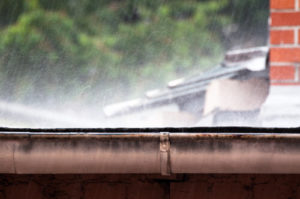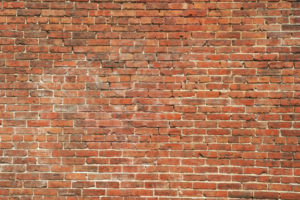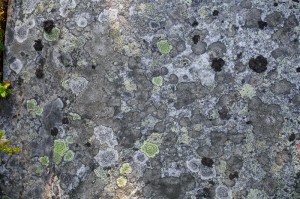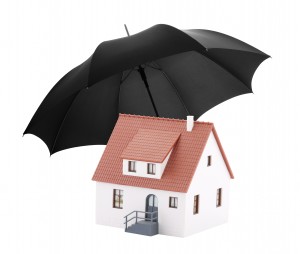by Billy Sweet | Aug 13, 2018 | Waterproofing
Your chimney may look healthy from the outside, but it may have a hidden problem that is wreaking havoc on all of the unseen parts. Because of the porous nature of masonry and the materials it is made of, masonry chimneys are highly susceptible to water penetration and damage, which may go unseen for many weeks or even months before anyone notices signs of a problem. By this time there is usually serious unseen damage within the system–damage that is 100 percent preventable.
Water Damage
Whether it falls in through an exposed flue, penetrates through the masonry, or seeps in through damaged flashing, water will produce the same result–damage. Water doesn’t only damage parts of the chimney itself, but usually results in other leaks that affect your home. When water comes in through the chimney system, it will travel through the structure of your home, in ceilings, floors, and walls until it pools in one low area where it will form a leak. For this reason, if you have a leak anywhere in your home, even rooms away from your chimney, it’s important to call a chimney professional. The chimney is the first thing that should be checked because it’s usually the culprit. Besides damage to the home, walls, floors, and furniture, the chimney takes on damage that is costly to repair.
Water causes serious damage to the chimney, including:
-Rust to parts, assemblies, ducts, and connections
-Deterioration of assemblies, masonry, mortar, and mortar joints
-Rotting adjacent wood, wall coverings, walls, and floors
-Water stains in home and masonry (interior and exterior portions)
-Cracks and damage to flue lining system
-Collapsed hearth support and foundation damage
-Leaning, tilted, or collapsed chimney structure
-Chimney settlement
-Odors, spores, and mold affecting breathable air in the home
Preventing Water Damage
At Billy Sweet Chimney Sweep we understand the importance of water damage prevention due to our sometimes harsh winters and proximity to ocean waters. Falling precipitation isn’t the only water that can penetrate the chimney system. Moisture in the air, especially corrosive moisture such as salt water, can be just as damaging to the masonry. It’s important to schedule routine maintenance with a chimney professional in order to make sure your chimney is protected against water penetration. At Billy Sweet we offer chimney inspections year round that will identify problems and hazards that put your chimney and home at risk. We also diagnose leaky chimneys, and the first thing we’ll check is the flashing because it’s often installed incorrectly. Billy Sweet will also check that your flashing, cap, crown, and masonry is in good shape and will keep water out. To add extra protection to the masonry, we apply a waterproofing product that will keep water out year after year.
Functional Waterproofing
It’s unsafe to put latex sealant or other outdoor water repellent products on your masonry. They may keep water out, but the chimney won’t work properly, or safely. The water repellent that we use at Billy Sweet actually repels water, keeping water molecules from getting in, while still remaining vapor-permeable so that gas and heat can escape.
We not only waterproof chimneys year-round, but we offer this service free after exterior masonry repairs!
To schedule your waterproofing services, call 781-593-2333 or contact us online.
by Billy Sweet | Nov 24, 2016 | Masonry Chimney
 Masonry is long-lasting and beautiful. However, the very same materials that make it strong and porous also make it susceptible to damages. Brick, mortar, concrete, stone, and cast iron are just some of the materials that make up masonry. All of these materials are adversely affected by moisture. This means that no matter how well your chimney was built, you may experience deterioration sooner than expected. This will happen if you don’t take measures to prevent water damage.
Masonry is long-lasting and beautiful. However, the very same materials that make it strong and porous also make it susceptible to damages. Brick, mortar, concrete, stone, and cast iron are just some of the materials that make up masonry. All of these materials are adversely affected by moisture. This means that no matter how well your chimney was built, you may experience deterioration sooner than expected. This will happen if you don’t take measures to prevent water damage.
Weather and Your Chimney
Water can affect every part of your chimney. From the inside out, rusting parts, rotting supports, cracking masonry, and more. The damage on the inside can be detected during a routine chimney sweep or inspection. However, you can often see damage occurring on the outside. When water penetrates the masonry, the water experiences a constant cycle of freezing and thawing. This can turn a hairline crack into a gaping crack as water expands. When it freezes, a widening a crack, allowing more water inside to freeze again. In addition to water from rain and snow, other natural occurrences can damage your masonry including sleet, wind, animals, and even some insects.
As the masonry is weakened, homeowners may begin to notice loose mortar. Even flakes and slivers of mortar, falling from the roof. If left unchecked, you might even find bricks falling from the roof, as mortar is loosened and the bricks become loose. This occurrence is called spalling, and should be a red flag for homeowners.
The Solution: Tuckpointing
The first thing to do when you notice a problem with your chimney is to contact a CSIA Certified Chimney Sweep® (CCS). Only a certified chimney sweep can assess the damage quickly and correctly. Plus, has the expertise to complete your tuckpointing or repointing job to restore your chimney completely.
Tuckpointing should never be left to an amateur. This detailed process of masonry repair includes removing the damaged mortar piece by piece, and replacing it with new. A chimney sweep who is inexperienced, or uncertified, may not mix the mortar correctly. This is because some amateurs mistakenly believe tuckpointing is strictly for looks. This is not true, and can be dangerous for your chimney and result in a shorter life.
At Billy Sweet, our technicians will match the new mortar with the color of the existing mortar. This will leave a beautiful finished product. However, we also know the importance of matching the strength and consistency of the new mortar with the old. Only an experienced chimney sweep can complete this task. If the mortar isn’t matched precisely, your chimney will not last.
Billy Sweet is licensed and insured. In addition, we send a CSIA certified chimney sweep on every job, and our technicians are expert masons. We will repair your chimney. Whether you need the chimney restored to full use, or if you need cosmetic repairs for real estate sales. We do a beautiful job in a professional manner, every time.
For more information about your spalling chimney, call Billy Sweet Chimney Sweep today or request an appointment online.
by Billy Sweet | Jul 15, 2014 | Chimney Maintenance

Water should’t be allowed to seep inside your chimney. Many chimney-related problems start with water intrusion.
A lot of what we do for our clients at Billy Sweet Chimney Sweep roots in prevention. We sweep your chimney regularly to prevent excess creosote build-up and potential fire hazards. We install chimney caps to prevent rain and snow from diving right into your flue opening. We apply waterproofing sealant to your masonry to prevent excess moisture intrusion and moisture damage. We inspect your chimney system every year in part to prevent lots of things: draft issues, water or carbon monoxide leaks, even just to prevent small problems from becoming larger, more troubling and more expensive problems.
If it seems like a big part of our preventative efforts are focused on fighting water, you’re right, and there’s good reason for that. Left unchecked, moisture intrusion can cause extensive damage to your chimney system and the exterior and interior building materials around them.
Want a deeper look into how much trouble water can be? Here are three ways water can ruin (or at least significantly damage) your chimney:
“The Freeze/Thaw Cycle”
We all know that water expands when it freezes — you only have to forget you put a glass bottle of soda or beer in the freezer once to brand that messy lesson into your mind. Let’s think about how that can pertain to a chimney. Over years of being exposed to the elements, your masonry can develop some small cracks, whether that’s in your mortar joints or chimney crown, or in your bricks themselves. Moisture can make its way into those small cracks and sit there as the temperature drops. Once it reaches freezing temperatures, that water freezes and expands, straining against the masonry material — and more often than not, the ice wins, causing your masonry to crack, flake and crumble (called spalling). Over time, that can leave you with enough damage to need your whole chimney crown rebuilt, or extensive repairs on your chimney stack.
To avoid extensive spalling and other damage related to the freeze/thaw cycle, Billy Sweet Chimney Sweep technicians aim to repair all cracks and imperfections while they’re still small, whether that means applying a crown coat seal to your chimney crown or tuck pointing your damaged mortar joints. It’s one of the many benefits of keeping up with your annual chimney inspections — we’ll be able to keep on top of issues before they turn into huge hassles.
Corrosion And Rust
We know what happens when metal and moisture collide, too: dark red rust and crumbly corrosion. Since several components in your chimney system are made of metal, rust and corrosion are a concern too. If, say, your chimney cap is missing and moisture is making its way into your flue, it might repeatedly soak your metal throat damper — the part that lets you open and close your flue when you are or aren’t using your fireplace. A rusted throat damper can get stuck, or its plate can corrode and break. Rusted chimney flashing or chase covers can allow moisture to damage the interior of your chimney and your home too.
Chimney inspections are another important part of preventing this kind of damage. But beyond that, we also recommend that clients with galvanized metal components look at replacements made with more durable materials — like stainless steel and copper — which won’t have that kind of vulnerability to rust and corrosion.
Chimney Mold
Mold growth doesn’t really “ruin” your chimney, but it’s absolutely a problem you need to be aware of, since exposure to mold is linked to a variety of health issues, from respiratory problems and allergic reactions and triggering asthma episodes. Mold feeds on moisture, so if a leak develops in your chimney, mold can get a chance to grow and proliferate. Mold remediation is a two-pronged process: We need to get rid of the mold, and we need to repair the leak that was feeding the mold. Billy Sweet technicians are trained in the safe and proper removal of mold, and we can also find and repair any damage that’s leading to leaks. We can also talk with you about some preventative measures that can help you avoid leaks, like chimney waterproofing.
If you have any concerns or questions about water and its relationship with your chimney, we’re always here to help. Give Billy Sweet Chimney Sweep a call!
by Billy Sweet | May 28, 2014 | Chimney Maintenance

Stop the growth of molds in your chimney by simply preventing water from intruding inside of it. Have your chimney waterproofed.
What is fuzzy and always found in places where it doesn’t need to be? No, not your family pet, but mold. Mold is extremely dangerous and can grow anywhere. Too often homeowners learn that mold is a problem in their home, and could have been prevented with proper maintenance. However, if it is found in time, it can be removed. To learn more about keeping your chimney mold free, call the experts at Billy Sweet Chimney Sweep. These guys can help with sweeps, inspections, and many other fireplace needs!
What is chimney mold?
The mold found inside of your chimney grows the same as any other type of mold you know of. Mold can grow in less than two days from a spot of standing water. If chimney mold is left long enough, it can spread into the foundation of your home. Because mold comes in a variety of textures and colors, you may not notice it when you see it. This is why it is important to have a Chimney Safety Institute of America (CSIA) certified professional come do your annual sweep and inspection.
How do you get rid of chimney mold?
Once you find out where the mold has begun to grow, you can begin to remove it. Chimney technicians will start by checking for cracks in the chimney’s structure and where flue precipitation collects. They will also do a controlled water test where they spray water on the chimney in increments so they can see where it absorbs. If your flashing has become damaged, there can also be water leaks. Flashing is the group of metal strips that form layers where the chimney and roof meet. Overtime, this can become loose, but can be repaired by your technician.
Even though you can technically remove a spot of mold less than three square feet by yourself, it is still recommended that you call a technician for safety. If it is not removed properly, it can continue to spread. Also, it can cause severe rashes if it comes into contact with your skin.
How can you prevent mold from growing in my chimney in the future?
You cannot prevent mold from growing completely, but you can reduce the chances by having your unit waterproofed. Your technician can have this done in a day if you only need one coat. However, if you live in a wet area, it is often recommended that you have two. This should be done on a dry day for the sealant to have top performance.
by Billy Sweet | Mar 25, 2014 | Chimney Maintenance
Chimneys add a certain aesthetic beauty to our homes and help keep our families safe from the smoke and harmful gases that would otherwise leak into our homes without them. Since we value them for the protection that they provide to our families, why shouldn’t we protect them a little, too? This is where chimney caps come into play. They’re not required by and laws or codes to be on our chimneys; however, it is strongly recommend that you consider having one installed.
What Purpose does a Chimney Cap Serve?

Chimney caps keep potentially damaging obstructions from getting into your chimney. Maintaining proper draft is key to optimal performance.
It’s quite simple actually. The basic job of a chimney cap is to cover the chimney’s opening in an effort to keep water, birds and other wildlife, leaves, twigs and other debris from getting into your chimney and/or house. Water is directed away from the center and off the sides of your chimney.
Birds, other wildlife, leaves, twigs and other debris are blocked from getting to your chimney via the mesh screening on the side, thereby preventing it from becoming a giant trash can. If any of these things were to get into your chimney, they could damage the chimney and cause more problems for you down the road. On the other hand, keeping them all out can increase the lifetime of your chimney liner.
What’s Your Ideal Chimney Cap Material?
Chimney caps are made from a variety of materials – galvanized steel, copper, stainless steel, and aluminum – and can be simple or ornate. Stainless steel caps generally give homeowners the most bang for their buck, as they are not impacted by the elements as much as are the other materials.
Galvanized steel and aluminum caps can and will eventually rust and need to be replaced, while shiny, more expensive copper caps will slowly weather and eventually end up the same color as the Statue of Liberty (some homeowners may actually prefer copper’s natural patina and will be willing to fork over the extra money for it; it’s purely a personal preference).
Why Should you Have a Chimney Cap Installed?
For those who are worried about the cost associated with a chimney cap, basic caps can be found at a pretty fair price. Deciding to purchase a chimney cap and have it installed by a professional chimney technician is a choice you won’t soon regret. It’s much cheaper to add a chimney cap now than to have to repair or replace your chimney liner sooner than you’d like.
It’s also a lot cheaper to have a cap installed than to hire a pest removal specialist to remove a family of raccoons from your chimney. Unless you just really want to get a visit from Ernie “The Turtleman” Brown or the Verminators, do yourself a favor and have a chimney cap installed. The certified staff at Billy Sweet Chimney Sweep can get your new chimney cap installed in no time. Your chimney and your family will both thank you.


 Masonry is long-lasting and beautiful. However, the very same materials that make it strong and porous also make it susceptible to damages. Brick, mortar, concrete, stone, and cast iron are just some of the materials that make up masonry. All of these materials are adversely affected by moisture. This means that no matter how well your chimney was built, you may experience deterioration sooner than expected. This will happen if you don’t take measures to prevent water damage.
Masonry is long-lasting and beautiful. However, the very same materials that make it strong and porous also make it susceptible to damages. Brick, mortar, concrete, stone, and cast iron are just some of the materials that make up masonry. All of these materials are adversely affected by moisture. This means that no matter how well your chimney was built, you may experience deterioration sooner than expected. This will happen if you don’t take measures to prevent water damage.

